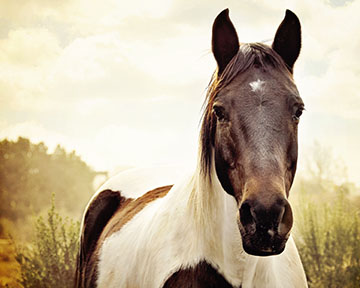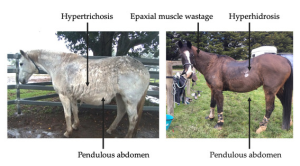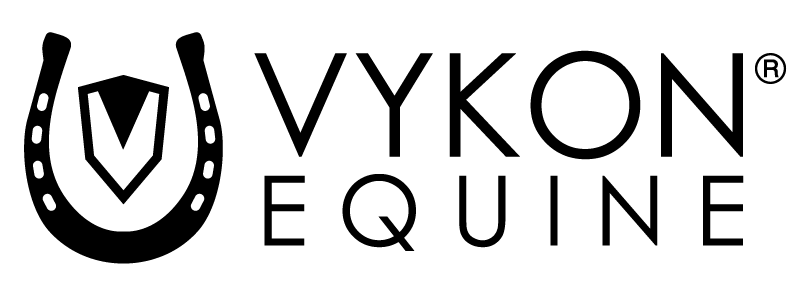
Pituitary Pars Intermedia Dysfunction in Horses aka Cushing’s Disease
This spring did you notice your senior horse did not shed as well this year? Maybe they were a bit more lethargic then usual, a little “pudgy” around their belly or their muscles seemed to be a bit atrophied? Well, it could be pituitary pars intermedia dysfunction (PPID), better known as equine Cushing’s disease. Once thought of as a rare condition, Cushing’s has become one of the most common endocrine conditions is geriatric horses. It is thought to effect between 20-25% of horses over the age of 15, although it can affect younger horses as well.
What is Equine Cushing’s Disease?
The pituitary gland is located at the base of the equine brain and is responsible for producing pituitary hormones. In horses with Cushing’s the part of the pituitary that is responsible for controlling the inhibition of pituitary hormone production is damaged. As a result of the damage to the pituitary the gland increases in size and produces more hormones. These increased pituitary hormones then effect the horse systemically. Early clinical signs of PPID are often missed as owners often associate the signs and symptoms with regular age-related changes. Cushing’s can be diagnosed by your veterinarian based on clinical signs and symptoms and testing of certain hormone levels.
Clinical presentation of PPID can include:
- Hypertrichosis (a long hair coat) or delayed shedding
- Abnormal fat deposition such as a cresty neck, on the tail head, around the eyes or in the sheath area
- Hyperhidrosis (excess sweating) or anhidrosis (lack of sweating)
- Muscle atrophy (especially along the top line)
- Weight loss
- A pendulous abdomen
- Recurrent infections
- Behavioural changes
- Lethargy
- Laminitis/lameness
- Insulin dysregulation
- Polydipsia and polyuria (drinking and urinating more than normal)
- Infertility
- Poor athletic performance
- Delayed wound healing
- Suspensory ligament degeneration
- Neurological abnormalities

Managing and Feeding horses with Cushing’s
PPID is usually managed by a veterinarian with medication. Additional nutritional and lifestyle recommendations can also be incorporated as many horses with Cushing’s also have insulin dysregulation issues or metabolic syndrome which can be supported well with diet and lifestyle changes (please note that not all horses with PPID have insulin dysregulation or metabolic syndrome but your veterinarian can do additional bloodwork to determine this).
For horses with PPID they can have very individual presentations and therefor there is no one-type-fits-all diet. They should be supported according to their specific needs considering things such as their age, weight, activity level, and body condition. Some thoughts on general diet and lifestyle recommendations for horses with PPID include:
- For horses with insulin dysregulation or metabolic syndrome it is usually recommended to have a diet low in sugar and starch with a quality source of protein. Regular exercise is also recommended as it reduces blood glucose levels in insulin-resistant people, so it is thought that this may also help horses. Additional dietary magnesium and chromium may also help reduce insulin resistance.
- Although some horses with PPID may be overweight many struggle to maintain a good topline and can often appear to be too lean with ribs showing. For these horses a quality source of protein is extremely important.
- It is recommended to have these horses’ (as well as all senior horses) teeth checked to make sure there is not a dental issue contributing to poor body condition.
- Internal parasites can contribute to decreased body condition as well so a good preventative program for internal parasites is important for these horses.
- Horses with hyperhidrosis or anhidrosis may have difficulty regulating their body temperature so clipping may be needed or shade to help them thermoregulate.
- Laminitis and founder are more common in horses with Cushing’s so extra care should be taken for horses with Cushing’s while grazing in pastures in the spring as the grass can be richer at this time. A grazing muzzle may be beneficial to limit the amount of grass that the horse can consume while still allowing them to be out and grazing.
- Make sure your horse has a proper balance of vitamins and minerals to support all their body functions. Studies have shown that there may be a correlation between low vitamin B12 and PPID in aged horses.
- Corrective farrier work for the management of laminitis if required.
- Blue light therapy has been shown to reduce the severity of hypertrichosis in horses with PPID
Discuss your horse’s diet with your veterinarian to come up with the best plan for your horse.
Horses and HTMA
In equine HTMA a hair sample is used to help assess the horse’s average mineral activity. A delicate balance of minerals is important for all living creatures as they are needed for millions of functions in the body. Minerals do not deposit randomly in the hair but instead deposit in distinct patterns. These patterns are less studied in animals than in humans, but more research is being done.
A common pattern to see in horses is the “4 low” pattern. In this pattern the big four minerals (Calcium, Magnesium, Sodium and Potassium) are all lower than ideal. Magnesium may play a role in insulin resistance and metabolic syndrome in horses as well, this link in humans has been studied but in equines more research is needed. Horses commonly also have low sodium and zinc.
By: Jenna Hartlen, CNP
Could your horse’s mineral balance be affecting their overall health and performance?
ASK US HOW HTMA CAN HELP YOUR HORSE TO FEEL, PERFORM, AND LOOK THEIR BEST!
References:
https://www.mdpi.com/2306-7381/9/10/556#B1-vetsci-09-00556
https://www.sciencedirect.com/science/article/pii/S1090023318300649?via%3Dihub
https://beva.onlinelibrary.wiley.com/doi/full/10.1111/eve.12160
https://thehorse.com/1111222/what-to-feed-the-newly-diagnosed-cushings-horse/




